- Updated: January 2, 2023
Fairway Wood vs. Hybrid
Fairway woods usually have more distance, less spin, and more opportunities to be used for tee shots than a hybrid golf club.
Hybrids tend to serve as a replacement for long irons’ because they are easier to hit.
Fairway woods are shorter in length than a driver, larger in size than a hybrid, and are usually regarded as a slightly more difficult club to hit accurate shots with.

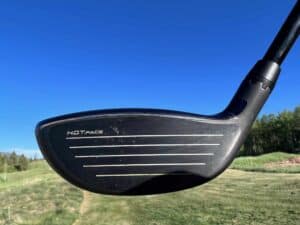
Hybrid clubs have more spin, more stopping power and combine the best aspects of long irons and fairway woods to create a club that’s easy to hit straight, accurately, and with a higher ball flight and trajectory.
In this article, our mission is to help you decide whether a fairway wood or hybrid club would best benefit your game and help you shoot lower scores.
Below we break down each club in detail and leave you with some key points to consider before you put a new club in your bag.
Fairway Wood Key Features:
Fairway woods are designed to be hit long distances, only second in length to the driver.
Fairway woods can be used off the tee or out of the fairway and have a shorter shaft than a driver, making them slightly easier to hit and control than a driver.
Fairway woods have higher lofts than drivers but lower lofts than hybrids.
The center of gravity in fairway woods is usually located towards the trailing end of the club head to achieve as much distance as possible. The center of gravity on hybrid clubs is generally located closer to the club’s face for better control and accuracy.
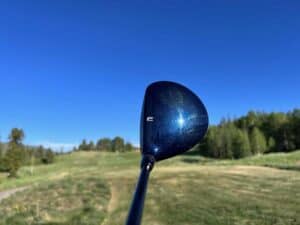
There are three primary fairway woods in the conversation, the 3 wood, 5 wood, and 7 wood. Which one you choose to put into your 14-club bag depends entirely on the yardage gap you’re trying to fill.
Depending on the club manufacturer, a 3 wood generally has a loft between 15 and 18 degrees, a 5 wood generally has a loft between 17 and 21 degrees, and a 7 wood generally has a loft between 21 and 24 degrees.
Pros and Cons of Fairway Woods
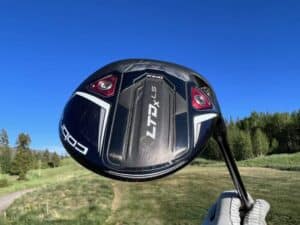
As you can see from the photo above, a fairway woods head (while still being larger in overall size than a hybrid golf club) is still relatively short in height compared to the golf ball.
This can be intimidating for beginner to intermediate players as the sweet spot is harder to find with the more compact face, and more precise contact and low point control are required to create consistent shots with the appropriate launch, distance, and trajectory due to the less forgiving sole than a hybrid.
Additionally, the flatter head shape of fairway woods can make hitting shots out of the rough or tricky lies much more complicated than using a hybrid.
On the contrary, modern fairway woods often have adjustable loft and lie features resulting in a more customizable feel for players that like to tinker with their equipment. Additionally, many newer fairway woods even have interchangeable weights, like drivers, for an even more custom feel.
Fairway woods are an excellent club for taking a more conservative approach off the tee or attacking a long par five in two. Fairway woods also hit the ball lower than hybrids, which is fantastic for windy conditions.
Since the loft of fairway woods is lower than hybrids, borderline nearing very close loft numbers to drivers, they offer another weapon off the tee when the driver isn’t cooperating that can still provide a decent distance. In contrast, hybrids usually lack too much distance compared to the driver to be considered another “weapon” on the majority of Par 4’s and Par 5’s tee boxes.
Since fairway woods have a lower loft than hybrids, the ball flight is usually lower and has less spin, making it more challenging to hold greens.
Pros of Fairway Woods:
1. More distance than hybrids.
2. Better for windy conditions due to their lower ball flight.
3. Longer tee shot alternative.
4. More of a weapon for tee shots than hybrids.
5. Often adjustable loft and lie settings on the loft sleeve.
6. Adjustable head weighting
Cons of Fairway Woods:
1. Lower trajectory and less spin make it harder to hold greens compared to hybrids.
2. Can be intimidating to beginner and intermediate golfers.
3. More difficult to hit out of rough or tricky lies due to less forgiving sole.
4. Longer shaft than hybrids, resulting in a longer swing and often less control than a hybrid.
Hybrid Golf Club Key Features:
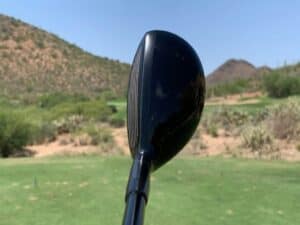
Hybrid golf clubs, also called the “Rescue clubs,” were initially introduced as a “game improvement” style golf club aimed at a player struggling to hit their long irons.
Hybrids are a relatively new addition to the potential clubs a modern golfer is carrying.
Many golf equipment manufacturers have begun offering a 3 hybrid as a 3 iron replacement when purchasing club sets due to the 3 hybrid being so much easier to hit than a 3 iron.
As you can see from the photo of the entire set comprising of hybrids, many golfers that struggle to make consistent contact with the ball adore how easy hybrids are to strike well.
Many senior players and lady golfers use sets comprising of more hybrids than irons or woods due to their forgiving nature and slower swing speeds.
There are many more options with the loft and name of hybrids than there are with fairway woods.
The name associated with the hybrid (3 Hybrid, for example) usually correlates to the iron golf club it’s meant to replace.
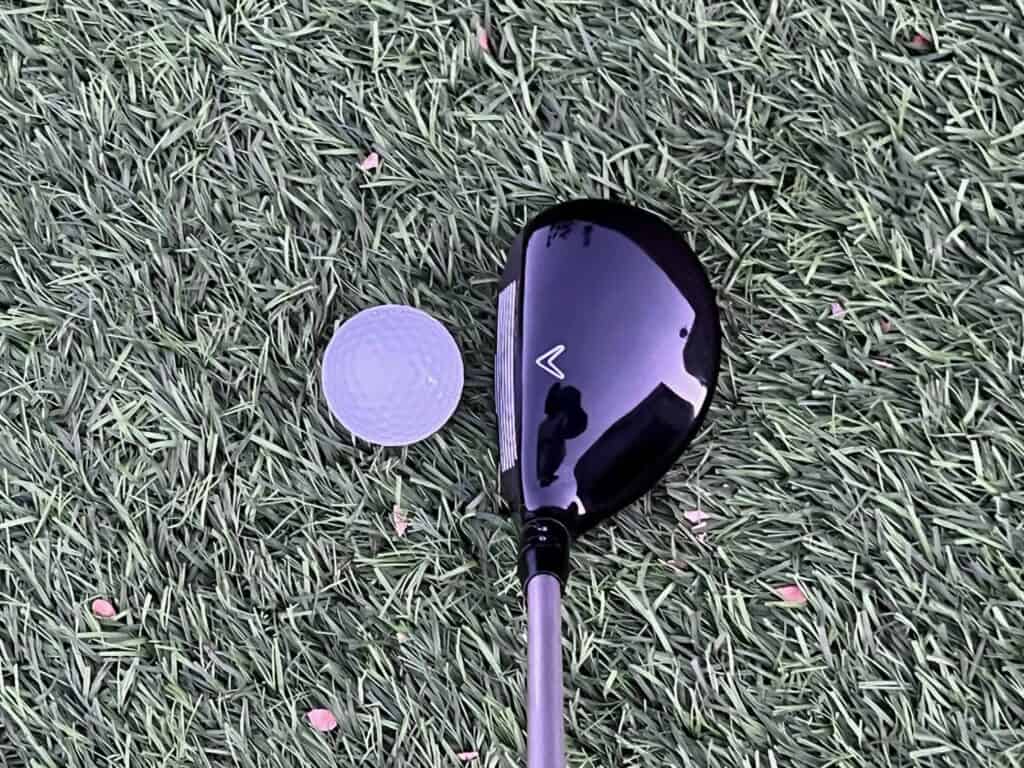
There are 2, 3, 4, 5, 6, 7, 8, and 9 hybrid club options, with lofts ranging from 17 to nearly 40 degrees.
Pros and Cons of Hybrid Golf Clubs
Even though hybrids have a smaller head size than fairway woods, they’re usually considered easier to hit than a fairway wood due to their shorter shafts.
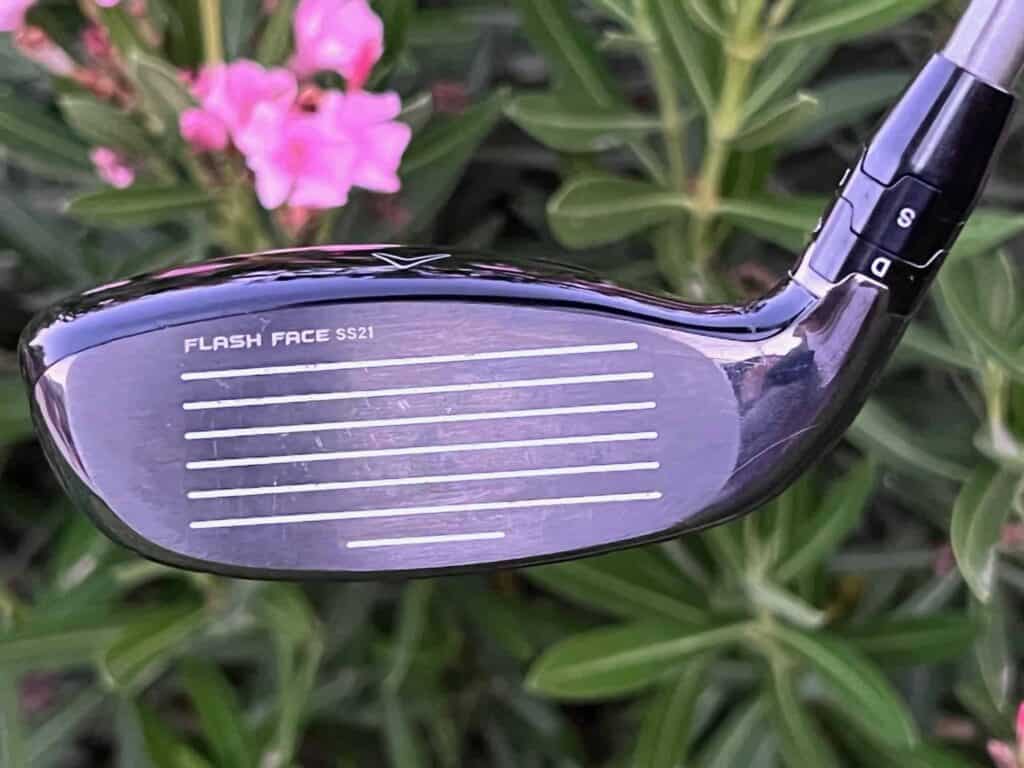
Hybrids combine a more forgiving sole design with added loft and a longer shaft than most long irons (yet still short enough to be very controllable), resulting in a much easier to strike club than long irons, just with less distance than a fairway wood.
The more forgiving sole design of hybrids and taller face profile makes them a great weapon out of tricky lies and the rough, particularly when up against the more unforgiving fairway woods.
Where long irons usually have a steel shaft, modern hybrids come standard with a light graphite shaft making the club lighter and easier to swing at faster speeds than a long iron.
Hybrids have a high launch angle and usually provide much more spin than fairway woods, making them easier to hit straight and giving shots hit with them a much higher chance of holding the green once hit.
Due to hybrids being designed to go straighter and be more forgiving, they are usually more challenging to shape. If you’re confident in your ball striking ability and want to be able to work the ball high, low, draw/fade, or hook/slice it, the fairway wood is a much better choice than the hybrid.
Hybrids often sacrifice the ability to be adjustable, like fairway woods, for more control right off the shelves.
Hybrids can be used off the tee for longer Par 3’s and shorter Par 4’s but serve their best purposes from the fairway and out of the rough.
Pros of Hybrid Golf Clubs:
1. Shorter shaft resulting in greater control than fairway woods.
2. The center of gravity is designed to cater towards better control and more precise shots.
3. More forgiving soles results in more options out of rough or bad lies.
4. More loft means more spin, meaning greater control and more stopping power.
5. More options for golfers looking to replace medium or long irons.
6. Shorter shafts = Easier to hit.
Cons of Hybrid Golf Clubs:
1. Less distance than fairway woods.
2. Less likely to be adjustable than a fairway wood
3. Less ability to shape the ball in different directions than straight.
4. Less ability to change the trajectory of the ball flight.
5. Less of a “weapon” off Par 4 and 5 tee boxes due to decreased distance.
Is There a "Middle Ground" Between Fairway Woods and Hybrids?
While the majority of your fairway wood or hybrid buying decisions will be based on your personal preferences when testing, there are options for clubs that serve as a sort of “in-between” possibility of the fairway wood and hybrid.
Many modern equipment manufacturers are experimenting with a “Utility Wood” that combines the best features of higher lofted fairway woods, the best features of hybrids, and a more neutral ball flight.
As a prime example, Callaway has just recently released their Apex Utility Wood.
Using direct feedback from top-level professional golfers like Phil Mickelson and Xander Schauffele, Callaway created a multi-purpose club that better players can rely on from the tee, fairway, or rough.
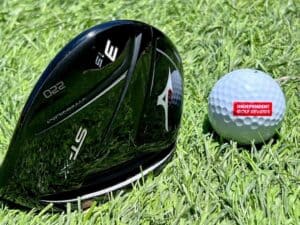
As you likely noticed from the photo to the left, the Callaway Apex “UW” looks like a slimmed down fairway wood or a bulkier hybrid.
It has a larger face profile and a neutral positioned center of gravity for a combination of high launch, steeper landing angles than fairway woods, consistent spin characteristics, and a 17% tighter down-range dispersion (taking some elements from hybrids).
Additionally, the club lengths of these “utility woods” are often set between a fairway wood and a hybrid, allowing for versatile playability while still being easier to hit.
If you’re not satisfied with the distance of your hybrid but trust your ball striking ability, clubs like the new “utility woods” or higher lofted woods like the 5 and 7 wood offer less distance and more control than a 3 wood, but more distance and shot making capabilities than their hybrid counterparts.
How Do I Choose One Club or The Other?
This is entirely dependent on the circumstances you find yourself in most often and the types of shots required at the golf courses you play most frequently.
If you’re consistently facing a shot into a green that is just out of reach of the longest iron you feel confident with, consider a hybrid or higher lofted fairway wood.
If you’re looking for another asset off tight tee shots or play longer golf courses with long approach shots into Par 5’s, you’ll want a lower lofted fairway wood over a hybrid.
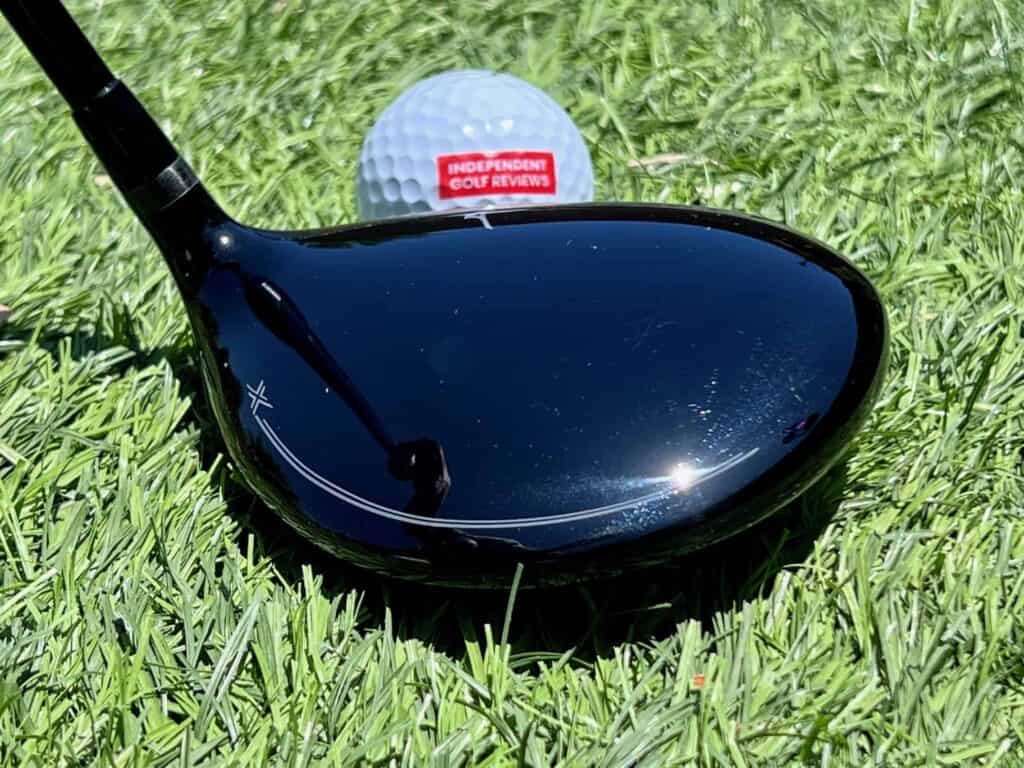
A hybrid could likely remedy the situation if you struggle to hold greens from long distances with your long irons due to a lower ball flight.
If you’re not confident in your long iron striking ability, get a hybrid.
If you are confident in your long iron striking ability, you can keep your long irons and experiment with different lofted fairway woods to gain a little more distance.
If you often find yourself playing in very windy conditions, a hybrid golf club’s naturally higher ball flight can cause trouble by being easier manipulated by the wind. A fairway wood is more suitable for consistently windy conditions and has more ability to control ball flight.
How to Choose What You Need Between a Hybrid and Fairway Wood
If you live in an area where you can test clubs, whether that be a professional fitting or just hitting into a net with something to record swing data, go with a specific yardage gap and trajectory you’re trying to fill.
Suppose you are a player that consistently finds the center of the club’s face. In that case, you can likely afford to sacrifice some of the game improvement technology hybrids have over a fairway wood for the additional distance if distance is what you’re after.
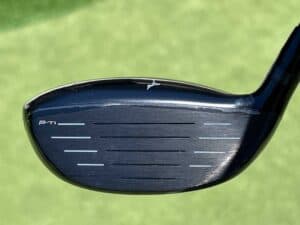
If you’re consistently in the rough and want a club that can “rescue” you from those situations, consider a hybrid or rescue club in the category.
2nd Swing Golf released a great video last year comparing the PING G425 7 Wood and the G425 Hybrid 3 Hybrid. They adjusted the lofts to ensure they were both tested at 20.5 degrees, and the results were quite interesting.
The overall distance of the two was relatively similar, but due to the specific players’ preferences and very consistent golf swing, they strongly preferred the 7 wood over the hybrid.
The player found more consistency in height, longer carry distance, and a tighter dispersion with the 7 wood.
The testers note most people should take their information with a pinch of salt, as the majority of players don’t have as consistent of a swing as the person testing in the video.
Players with steeper swings that produce more backspin on their own (90%+ of amateur players) could see just as consistent results with a hybrid.
This gives even more credit to the idea that everyone should test clubs before they purchase them!
About The Author
Writers of Independent Golf Reviews
Independent Golf Reviews has tested and reviewed 1000+ golf products over the past 10 years. We use our experience and expertise to give golfers an unbiased insight on the market.
Read more…
Share
Receive the best golf discounts available exclusively for our subscribers and be auto entered into our monthly golf giveaways!
Success!⛳️
You are now an official member of IGR. Keep an eye out for the perks.
No spam, ever. 🔒

